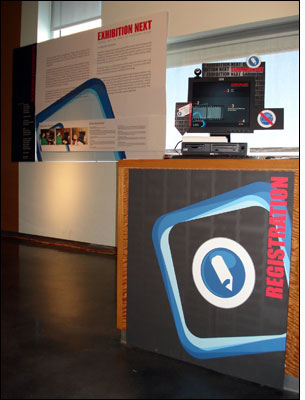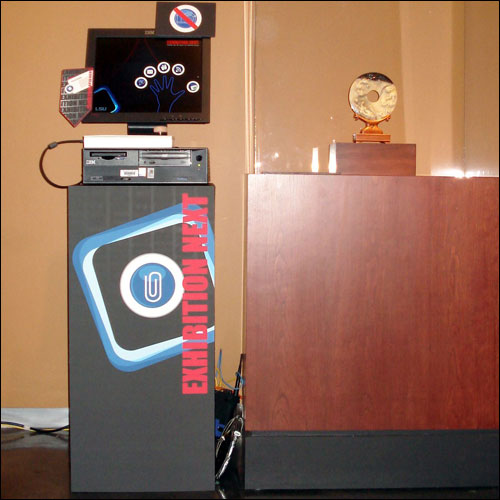Students and faculty members at Louisiana State University (LSU) have designed an exhibition system using RFID technology that allows museums to track visitors’ interests in exhibits, while also enabling those patrons to receive e-mailed messages containing information about the particular exhibits they visited. A prototype of the system was piloted at the LSU Museum of Art for one week in December, says Santanu Majumdar, one of the system’s developers. The next step for the researchers, he adds, is to further test the system at other locations, and then gain investment partners and make it commercially available.
Majumdar—an LSU student at the time (he has since graduated)—and his colleagues at LSU’s Center for Computation & Technology (CCT) were focused on developing a system that would enable museums to gauge the popularity of exhibits and provide paperless information to visitors. Many museums receive funding through grants requiring that they prove how popular their exhibits are with patrons. To learn how guests feel about specific exhibits, museums often ask them to fill out forms indicating their opinions regarding the exhibits they visit, and also provides personal information. In addition, the museums typically offer information about exhibits in the form of flyers and brochures, which patrons usually carry home and later discard, thus causing added printing expense for the museum, while also wasting paper.

The Exhibition Next system solves both problems, Majumdar says. Upon arrival at the museum, a visitor goes to a registration desk to pick up a card provided by Canadian RFID technology supplier Phidgets. The card contains a high-frequency (HF) 13.56 MHz tag complying with the ISO 18000-3 standard. At that kiosk, the patron taps the card against a reader cabled to a computer, after which he or she is prompted to input his or her e-mail address and name, and then pose for a photo taken with a digital camera at that same location. The picture, name and e-mail address are then stored in the Exhibition Next software. According to Majumdar, the e-mail address enables that individual to request data while walking through the exhibits, which is sent directly to his or she e-mail address, and the photo provides security by linking that individual’s face, name and e-mail address. When an e-mail is sent to the patron, his or her picture is sent along with it, which Majumdar believes would deter visitors from providing an incorrect name or address.
Once the card is activated, the user then walks through the museum. Installed next to certain items on display is a kiosk with an RFID reader connected to a desktop computer. If a patron is interested in learning more about a displayed object, or obtaining a picture of that object, he or she can tap the tag against the reader adjacent to that item. In the case of a very large deployment, the system could include a single reader connected to multiple antennas, each installed near an individual exhibit. The card’s ID number is then sent via a cabled connection to the computer, where software—designed by Rajesh Shankaran, a graduate student in LSU’s department of computer science—looks up the e-mail address associated with that ID number, and sends data specific to that exhibit item directly to that address. The visitor can then immediately access that data on his or her phone with an Internet connection, or view it later on a computer, either at home or at some other location with Internet access. The patron also has the option of watching related information on a video displayed on the computer’s screen.
Upon leaving the museum, the patron returns the RFID card to the kiosk. Data about that person is then erased from the software so that a subsequent visitor can use the card.For the pilot, Majumdar installed three interrogators and provided 10 RFID cards. Based on the pilot’s results, he says, he plans to custom-design a solution for other museums or exhibitions, to be used for several more trials of the technology. The cost of the system to the museum would be minimal, Majumdar indicates, but the exact amount would depend on the total number of exhibits, as well as the number of readers installed at each exhibit. The RFID cards would cost approximately $1.25 per card, while the reader would cost around $65.

The LSU Museum of Art was very excited about the possibilities of Majumdar’s project, says Thomas Livesay, the museum’s executive director. “It’s perfect for the many university and college students that we have coming to the museum,” he says, since it enables them to have the information e-mailed to them, to be reviewed at their leisure. “Often, you see an object or painting while at a museum, but find that there is little or no information in an accompanying catalogue or on the walls,” he says. “This system could well be the wave of the future, to provide an intelligent solution for accessing collections.” In addition, he notes, the system would help the museum better track its exhibits’ popularity. “The system would be an invaluable aid in tracking the popularity of specific works of art, or entire exhibitions.”
Other museums have also deployed RFID systems as a way of augmenting the information they provide to patrons. In 2004, for instance, the Museum of Natural History in Aarhus, Denmark, mounted an RFID tag next to each bird on exhibit, and loaned visitors a PDA equipped with an RFID reader (see Museum Puts Tags on Stuffed Birds).
Another example is The Tech Museum of Innovation, located in San Jose, Calif. In 2005, the museum launched a program whereby visitors can receive an RFID tag that they can then use to select the language of the content displayed at the exhibits they visit while at the museum, as well as gather information for later viewing on personalized Web pages (see RFID Works Like a Charm at The Tech).

